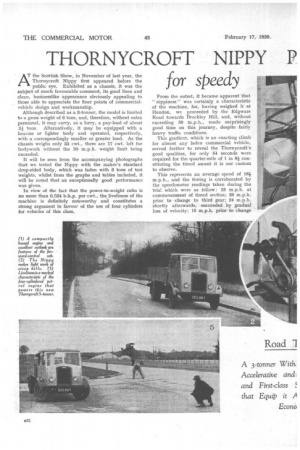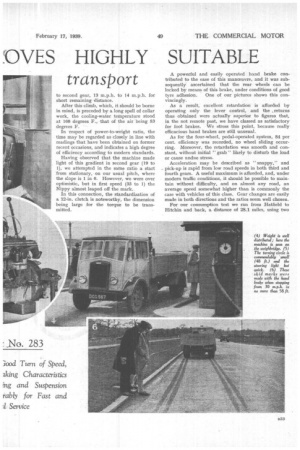THORNYCROFT NIPPY OVES HIGHLY SUITABLE for speedy transport
Page 42

Page 43

Page 44

Page 45

If you've noticed an error in this article please click here to report it so we can fix it.
ATthe Scottish Show, in November of last year, the Thornycroft Nippy first appeared before the public eye. Exhibited as a chassis, it was the subject of much favourable comment, its good lines and clean, businesslike appearance obviously appealing to those able to appreciate the finer points of commercialvehicle design and workmanship.
Although described as a 3-tonner, the model is limited to a gross weight of 6 tons, and, therefore, without extra personnel, it may carry, as a lorry, a pay-load of about 31 tons. Alternatively, it may be equipped with a heavier or lighter body and operated, respectively, with a correspondingly smaller or greater load. As the chassis weighs only 33 cwt., there are 17 cwt. left for bodywork without the 30 m.p.h. weight limit being exceeded. .
It will be seen from the accompanying photographs that we tested the Nippy with the maker's standard drop-sided body, which was laden with 3 tons of test weights, whilst from the graphs and tables included, it will be noted that an exceptionally good performance was given.
In view of the fact that the power-to-weight ratio is no more than 0.534 b.h.p. per cwt, the liveliness of the machine is definitely noteworthy and constitutes a strong argument in favour of the use of four cylinders for vehicles of this class.
From the outset, it became apparent that " nippiness" was certainly a characteristic of the machine, for, having weighed it at Hendon, we proceeded by the Edgware Road towards Brockley Hill, and, without exceeding 30 M.p.h., made surprisingly good time on this journey, despite fairly heavy traffic conditions.
This gradient, which is an exacting climb for almost any laden commercial vehicle, served further to reveal the Thornycroft's good qualities, for only 54 seconds were required for the quarter-mile of 1 in 8+ constituting the timed ascent it is our custom to observe.
This represents an average speed of 16/ m.p.h., and the timing is corroborated by the speedometer readings taken during the trial which were as follow; 25 m.p.h. at commencement of timed section; 20 m.p.h. prior to change to third gear; 24 m.p.h. shortly afterwards, succeeded by gradual loss of velocity; 10 m.p.h. prior to change to second gear, 13 m.p.h. to 14 m.p.h. for short remaining distance.
After this climb, which, it should be borne in mind, is preceded by a long spell of collar work, the cooling-water temperature stood at 168 degrees F., that of the air being 53 degrees F. • In respect of power-to-weight ratio, the time may be regarded as closely in line with readings that have been obtained on former recent occasions, and indicates a high degree of efficiency according to modern standards.
Having observed that the machine made light of this gradient in second gear (19 to 1), we attempted in the same ratio a start from stationary, on our usual pitch, where the slope is 1 in 6. However, we were over optimistic, but in first speed (33 to 1) the Nippy almost leaped off the mark.
In this connection, the standardization of a 12-in, clutch is noteworthy, the dimension being large for the torque to be transmitted. A powerful and easily operated baud brake contributed to the ease of this manceuvre, and it was subsequently ascertained that the rear wheels can be locked by means of this brake, under conditions of good
tyre adhesion. One of our pictures shows this convincingly.
As a result, excellent retardation is afforded by operating only the lever control, and the _returns thus obtained were actually superior to figures that, in the not remote past, we have classed as satisfactory for foot brakes. We stress this point, because really efficacious hand brakes are still unusual.
As for the four-wheel, pedal-operated system, 84 per cent. efficiency was recorded, no wheel sliding occurring. Moreover, the retardation was smooth and constant, without initial " grab " likely to disturb the load or cause undue stress.
Acceleration may be described as" snappy," and pick-up is rapid from low road speeds in both third and fourth gears. A useful maximum is afforded, and, under modern traffic conditions, it should be possible to maintain without difficulty, and on almost any road, an average speed somewhat higher than is commonly the case with vehicles of this class. Gear changes are easily made in both directions and the ratios seem well chosen. For our consumption test we ran from Hatfield to Hitchin and back, a distance of 28.1 miles, using two gallons of petrol The consumption rate this repre
sents may be regarded as entirely satisfactory, particularly in view of the fact that the carburetter setting with which it was obtained affords ample power. ln evidence, the hill out of Hitchin, travelling southwards, was climbed in top gear, without struggling, the speed falling from 20 m.p.h. at the foot to 141m.p.h. at the summit. Admittedly, the torsional impulses could be felt when the crankshaft revs, had dropped, but there was no snatch or knocking.
While ascending Welwyn Hill, we came up with a slower vehicle in front of us; thus was an ideal opportunity afforded to demonstrate " nippiness." In order to avoid being baulked, a quick change-down was made to " third " and the slower machine smartly overtaken without delay to ourselves or more than momentary obstruction of the road.
After these experiences, we anticipated a fast climb of the longer, but more gently graded, Digswell Hill, and actually maintained 29 m.p.h. to 30 m.p.h. all the way up, the power unit "hanging on" in truly praiseworthy manner.
Our one-gallon test tank was replenished in Hitchin, just before the turning point, so that almost equal distances were traversed on the respective gallons.
From the point of view of driver's comfort, the fol lowing observations merit recording. Neither noise nor vibration in excess is created by the power unit, and the former, together with heat generated, is largely confined within the bonnet, so that the cab is comparatively quiet and cool. Incidentally, surprisingly little space is occupied by engine and cowling.
A coach-built structure, the cab is commodious and comfortable, and especial care has been given to out look. There is a wide rear window, the front pillars are slender, and the windscreen extends well downwards at both sides so that objects on the road are visible when quite near to the front of the vehicle.
An instrument panel is conveniently mounted on the steering column, the leads passing to it through an armoured flexible conduit. Behind the driver's seat is the accumulator, and near the gear lever protruding through the floor is the Lockheed-fluid container provided with a good hexagon filler cap.
On the near side, in front of the passenger's seat, is housed an Autoyac-a device preferred by some operators as a means for raising fuel from tank to carburetter, An electric screen wiper is standardized.
Although the power unit appeared, during our day's test, to be a certain and easy starter, we are inclined to deprecate the fact that an electric starter is not included in the standard specification, but listed as an extra. To our mind this is hardly moving with the times. Obviously, it is merely a matter of price, but a selfstarter seems to have become a recognized item in the make-up of the modern medium weight. Another minor criticism may be made in connection with the machine's frontal appearance. In ,its original form it was equipped with a neat radiator grille. This• was of notably pleasing design, represented no waste space and served a useful function. Without it the model looks unfinished, whilst the grille, when in place, markedly enhanced the appearance of the whole. In our view it is a pity that its use has been dropped.
With matters of greater practical importance, how. ever, we have no faults to find. As an example, the suspension system may be named. Marked progress seems to have been made, recently, in connection with springing, and this Thornycroft, whilst riding smoothly over bad surfaces, appears to have a suspension that should be wholly adequate for long service under arduous operating conditions.
Our impressions generally may be summarized by making the obvious remark that the Nippy lives up to its name ; further, we feel justified in suggesting that such a vehicle as this can provide a good answer to those who question the economy of paying a relatively high price for a machine of first-class quality.




















































































